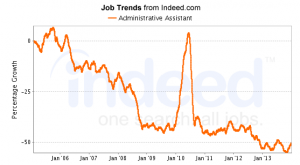 If you place administrative staff, you know the market has been soft. After spiking up shortly after the U.S. began to emerge from the depths of the recession, job growth has been, at best, flat. As the accompanying chart from Indeed shows, the trend for administrative assistant titled jobs has been decidedly negative.
If you place administrative staff, you know the market has been soft. After spiking up shortly after the U.S. began to emerge from the depths of the recession, job growth has been, at best, flat. As the accompanying chart from Indeed shows, the trend for administrative assistant titled jobs has been decidedly negative.
However, we’re just beginning to see an emerging market in healthcare for skilled clerical workers. The demand for medical scribes, an old, now new occupation, is growing at a furious pace.
In 2008, the first of the medical scribe staffing firms, PhysAssist in Forth Worth, Texas, had 35 scribes. Today it has 1,400. By one estimate, there may be as many as 10,000 medical scribes at work, mostly in emergency rooms and in high patient environments.
A combination of factors, however, is pushing the expansion of medical scribes into clinics, other hospital departments, and, increasingly, into doctor’s offices.
Medical scribes are silent recorders of doctor-patient interactions, documenting the discussion, the diagnosis, treatment plan and, later, after the records have been reviewed and approved by the doctor, entering the billing code. Many scribes also perform other duties, some of them more clerical such as scheduling patient visits.
Historically, these jobs have been filled by pre-medical students or upper-level undergraduates in other health programs. With the demand now outstripping the supply, scribes with backgrounds in other areas are finding work.
Requirements typically now include some college, English proficiency, good listening skills, administrative or clerical experience, and a willingness to learn medical terminology and the arcane coding and billing of medical procedures. Training is required, and firms like PhysAssist are offering free programs and paid residency.
Pay for scribes ranges up to about $25 for the most experienced and knowledgeable professionals. Most, though, average around $16 or $17 an hour, slightly more than they would for office work.
The growth is driven by the federal mandate that all medical records be digitized. Offices and facilities that fail to make the switch to computerized records face the reduction or loss of Medicare and Medicaid reimbursements. The Health Information Technology for Economic and Clinical Health (HITECH) Act included significant financial incentives for making the switch.
Further prompting came from the looming implementation of ICD-10, an illness and injury classification system that will increase the current 13,000 or so codes (also used for billing) by a factor of 10 when both the ICD-10 CM and ICD-10 PCS are included. (The former has about 68,000 codes for clinical diagnoses, while the latter, though separate, is an expansion of the ICD-10 CM that codes for procedures.)
In a move opposed by even the American Medical Association, Congress has pushed the required implementation from October to October 1, 2015. The AMA’s opposition is less about delaying than killing the adoption of the ICD-10 coding altogether.
By shifting the paperwork burden to scribes, physicians are able to increase the number of patients they see without sacrificing the time they spend with each.
In a blog post for The Wall Street Journal Dr. Allan Bank cited a study his clinic did finding a scribe increased doctor productivity by 50%.
Bank, director of research at the United Heart & Vascular Clinic of Allina Health in St. Paul and an associate professor of cardiology at the University of Minnesota, noted,
Although the time spent in each patient’s room was reduced by about 30%, the time in direct interaction with the patient (e.g., without the computer for entering patient information) increased significantly, and an independent assessment of physician-patient interaction was judged improved.